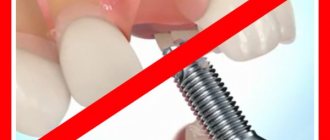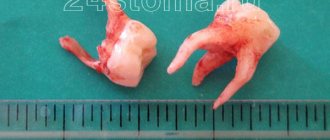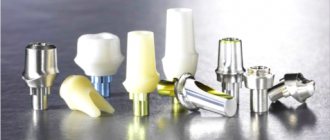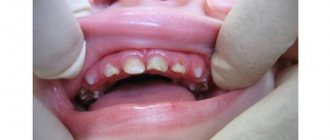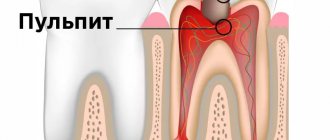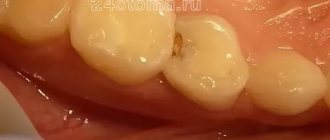Why re-treat canals?
Endodontic dental treatment is not always carried out in line with modern trends and requirements. According to statistics, complications in the form of chronic inflammation occur in 60-70% of patients. Treatment of dental canals is a painstaking work that must be performed by an experienced doctor using modern high-precision equipment and functional tools.
The following shortcomings of the previous intervention may serve as a reason for revising the channels:
- the presence of unfilled areas (voids). The reason is incorrect measurement of the channel length and insufficient machining;
- poor-quality filling materials, due to poor fit of which the canals become depressurized and infection opens;
- fragments of pins and instruments stuck in cavities;
- passage of additional channels and closing them along with the remains of the pulp (creation of an infectious “depot”). Molars usually have three canals, but there are specimens with four or five - they are the ones that remain “unaccounted for”;
- insufficient expansion and poor-quality cleaning of canals, formation of “steps” and root perforations due to deviation of the instrument from the anatomical shape of the course. The result is an under-processed apical part of the root (the apex of the root in dentistry means its lowest point).
As a result, the infection from the canal enters the gum tissue, and foci of chronic inflammation develop at the root tips - apical granulomas and radicular cysts. Such formations were previously considered an absolute indication for tooth extraction (cystectomy).
Endodontic treatment of tooth canals using optics
Such verdicts were completely justified, since a progressive cyst can lead to gum deformation, destruction of bone tissue (osteomyelitis), periodic inflammation and suppuration. Some dentists still consider removing a tooth with problematic roots to be the only rational option.
The IMEZA clinic has the personnel and technological capabilities for complete sanitation of cystic formations while preserving the dental unit. Our specialists have experience treating patients who were previously scheduled for tooth extraction due to the presence of foci of chronic inflammation. But there are cases when cystectomy is really the only option - destruction of more than 2/3 of the root or the impossibility of restoring the functionality of the dental unit.
Timely retreatment of questionable canals will help avoid complications and tooth loss. Our doctors objectively assess the risks and feasibility of manipulation for each individual patient, taking into account the degree of destruction of the crown and roots, the functional load on the tooth, and the possibility of subsequent restoration.
Reasons for re-treatment
Canal retreatment is carried out if:
- the initial treatment was of poor quality (the roots of the tooth were poorly cleaned or not completely filled);
- re-infection of the tooth occurred;
- inflammatory processes have begun;
- there was pain in the tooth;
- a fistula has formed;
- swelling is noticeable;
- the tooth became sensitive to percussion.
Tooth canals are also re-treated before prosthetics to prevent inflammation and tooth decay.
The reasons for poor quality primary treatment can be:
- unprofessionalism of the doctor or lack of experience;
- lack of knowledge of endodontic treatment protocols;
- lack of necessary equipment;
- use of low quality filling materials;
- incorrect diagnosis;
- instrument fragments remaining in the tooth canal;
- root perforation;
- anatomical features of the canals (narrowness of the canals, atypical location of the inputs, the presence of convolutions or steps);
- morphological changes in dental canals (obliteration, calcification, hypercementosis);
- filling or prosthetics of a tooth after a long period of time after root canal treatment.
Signs of canal infection
In some cases, patients can independently determine the presence of problems with a previously treated tooth. The main signs of canal infection are:
- pain that did not go away after treatment or occurred some time after it;
- a feeling of fullness in the gums, discomfort when pressing on the tooth;
- the presence of swelling, swelling on the gums, as well as the formation of a fistulous tract (cyst breakthrough);
- changing the shade of the dental crown from light to gray. This may indicate dentin destruction;
- persistent unpleasant odor.
If you have the above symptoms, you should not waste time by self-medicating. At the IMEZA clinic, the patient can count on a quick, accurate diagnosis and adequate treatment.
Cost of re-treatment of teeth under a microscope
Prices in different clinics vary from 5,000 to 25,000 rubles. The price varies depending on the status of the clinic, the qualifications and experience of the doctor, the chosen treatment method, the quality of the material, and the complexity of the intervention itself. But this is inexpensive compared to if you don’t use a microscope, re-treat not completely, and again encounter an infection in the same tooth. According to statistics, 70% of teeth can be treated under microscope control with a favorable outcome, but previously they were only removed.
Under the compulsory medical insurance policy, you can only receive a limited range of services. And endodontic treatment under a microscope is not included in the list. Private clinics do not work with compulsory medical insurance policies. The cost of retreatment under a microscope is not much different from the same, but without modern equipment. But diagnostics in the case of a microscope are an order of magnitude higher and more accurate. And the result can be used for many years, and no further dental intervention will be required.
On our portal you will find clinics with highly qualified specialists who know how to use a microscope to carry out modern, high-quality treatment.
Stages of canal retreatment
The procedure for re-treating the canals begins with providing access to them: removing the crown or removing (drilling out) the old filling, removing the stump inlays and pins. Then the canal cavities are freed from the filling material.
One of the stages that determines the quality of endodontic treatment is the correct measurement of the working depth of each canal. The most accurate result is obtained when using an apex locator - an electronic device connected via an electrode to a radiopaque K-file (a thin instrument immersed in the canal). As the K-file approaches the lowest point of the canal (apical constriction), the apex locator signal intensifies. An x-ray helps to clarify the readings of the device.
To ensure proper filling of the canal and adhesion (adhesion) of the filling material to its walls, preliminary mechanical treatment is necessary. Cleaning is done with hand instruments (high risk of breakage) or using an endodontic tip into which nickel-titanium profiles (thin drills) are inserted.
The intensity of rotation of the profiles is controlled by a micromotor, which triggers a reverse if the permissible pressure is exceeded. This method guarantees the absence of perforations, nicks and eliminates breakage of the instrument in the canal. Ultrasonic scalers and dentin softeners are used as auxiliary measures. This promotes maximum preservation of healthy tissue.
An important component of the canal revision process is their sterilization. The cavity is thoroughly washed and disinfected with antiseptics. In the presence of inflammatory formations, the following measures can be taken:
- opening the gums and excision of the root apex or complete removal of one of the roots (hemisection);
- laser removal of infected tissue;
- sanitation of channels through electrophoresis with calcium and copper ions.
After sterilization, filling material is placed. If the working length is incorrectly determined during machining, the top of the channel opens and the material flows beyond its limits. As a result, the patient will be bothered by prolonged pain, inflammation and neuralgia. At the IMEZA clinic, such errors in treatment are excluded.
The retreatment procedure is associated with additional damage to the coronal part, therefore, in some cases, its position is strengthened using an intracanal pin. Manipulation is possible if the layer of dentin surrounding the pin is at least 2 mm. Installation includes the following steps:
- preparing the bed using a calibration tool;
- adjusting the length of the pin;
- etching and drying the bed;
- applying adhesive material directly to the pin or into the cavity of the bed;
- installation of the rod, polymerization of the adhesive mass.
After completing the canal filling work, the dental cavity is closed with a temporary filling. At the next visit, the doctor begins to restore the upper part of the tooth using an artificial crown, inlays or volumetric restoration techniques.
After treatment, discomfort when biting on a tooth may persist for 3-5 days. If there are no complications, you should return for a routine examination in a year.
How is the procedure done?
Root canal retreatment consists of several stages:
- anesthesia is administered;
- open the tooth and remove the filling;
- open the dental canals and remove the filling material;
- perform an audit of channels;
- treat the entire length of the dental canals to completely eliminate the source of inflammation;
- the tooth canals are re-filled in accordance with the endodontic treatment protocol;
- restore the dental crown using fillings or prosthetics.
The most important stage of re-treatment is cleaning the canals from pathogenic microorganisms and remnants of the previous filling. It is produced mechanically using special equipment and attachments of various sizes and shapes. Medicinal treatment is also possible. But despite their high efficiency, mechanical and medicinal cleaning cannot guarantee one hundred percent destruction of the infection. Processing becomes difficult when the channels are highly branched and tortuosity. Therefore, transcanal ultraphonophoresis, intracanal electrophoresis, and depophoresis can be additionally used.
For repeated filling, antiseptics are added to filling materials. During the procedure, it is necessary to carefully monitor the high-quality filling of the canals so that the inflammatory process does not begin in the future.
Microscope or X-ray
Currently, dentistry uses two types of control over the treatment process: x-ray and using a microscope. X-ray is inferior both in terms of diagnostic capabilities and from a safety point of view:
- Some types of pins and composite materials are not visible in the photographs, which blurs the objective picture of the condition of the dental canals;
- optical distortions and channel overlap are possible;
- if there is liquid in the cavity, then the x-ray will not show it;
- To diagnose and monitor the treatment of the canals, a series of images will be required, and this, although insignificant, is still radiation.
A dental microscope is capable of magnifying the image 30 times - the doctor will notice the smallest tissue defects. You can easily detect the mouths of additional canals, examine their most tortuous configurations, assess root damage and monitor the quality of cleaning.
The microscope allows for unsealing with ultrasound, thereby preserving a large volume of valuable healthy tissue. Optics has significantly expanded the possibilities of dentistry in terms of restoring teeth that were previously considered hopeless. Treatment under microscope control almost completely eliminates the development of recurrent inflammatory processes and ensures long-lasting results.
Patients of the IMEZA clinic can count on high-quality canal retreatment using high-precision optical equipment, technological instruments and modern materials. It is enough to make an appointment, during which experienced doctors will identify all potentially dangerous elements and determine the optimal therapeutic tactics.
Prerequisites for the disease, methods of endodontic treatment
Most often, the root cause of infection is sudden or sequential damage to the hard tissue of the tooth, as a result of which bacteria penetrate into the root cavity and inflammation of the pulp occurs. This is characterized by the occurrence of acute pain, which intensifies upon contact with cold or hot food, as well as simple touches to the tooth.
Root canal treatment in such cases is not only recommended, but also necessary, since without it, the infection begins to spread rapidly, affecting adjacent healthy teeth, as well as soft tissues. The tooth itself begins to decay. Let's consider possible dental treatment options:
— removal of the tooth (or what’s left of it) is inevitable in advanced cases, however, by starting treatment at an early stage it is possible to save it. It is worth noting that removal, although it is an effective solution, has its side effects - in particular, it can provoke deformation of the position of adjacent teeth and disruption of a healthy bite;
— tooth extraction followed by implant installation. This method reduces the negative consequences of conventional removal, however, in any situation where there is a possibility of saving a tooth, it should be used, since even the most expensive implant is not capable of becoming a 100% functional replacement of a real tooth. In addition, implant placement is an expensive procedure; in most cases, endodontic treatment, started in a timely manner, turns out to be not only preferable, but also cost-effective;
- endodontic therapy - we outlined its principle at the beginning of the article. This type of therapy is characterized by the highest degree of effectiveness, allowing you to quickly get rid of the infectious inflammatory process and maintain dental health. Depending on the degree of tooth damage and the advanced stage of the disease, treatment may take several visits (no more than three). The first step is to provide access to the root canal and clean it, followed by disinfection and filling with solution. However, if the infection is widespread, as well as the presence of several canals, repeat visits to the dentist will be required. The final step will be to install the seal. This stage is very important, since a tooth deprived of pulp (and with it a significant part of its nutrition) becomes weak, and installing a filling (and in some cases, a crown) allows it to be strengthened.
The need for retreatment of teeth before prosthetics
The impeccable condition of the root canals during prosthetics is a guarantee that serious complications such as residual pulpitis, inflammation of periodontal tissue, the formation of granulomas and cysts will not arise in the future. Therefore, if the doctor recommends re-treatment of teeth before prosthetics, this must be done, despite the time and additional costs.
Proper treatment is the key to the long service life of the orthopedic structure, since if any problems arise with the supporting teeth, the crown or bridge will have to be removed and then re-prosthetics must be performed.
There are retrograde treatment options, but they are quite traumatic and not always effective. So it is better to insure yourself against troubles in advance and have your teeth re-treated before prosthetics.

